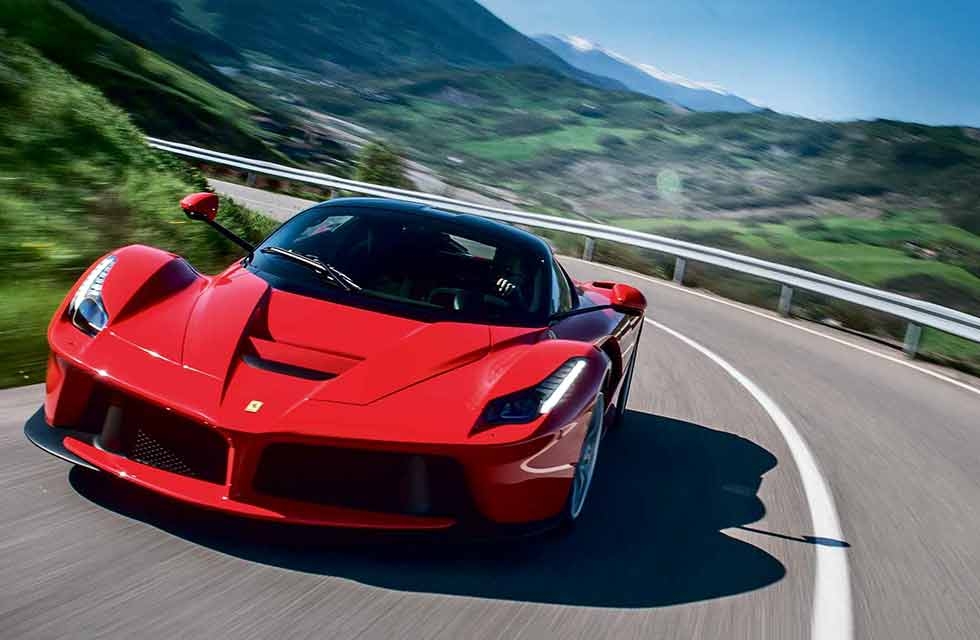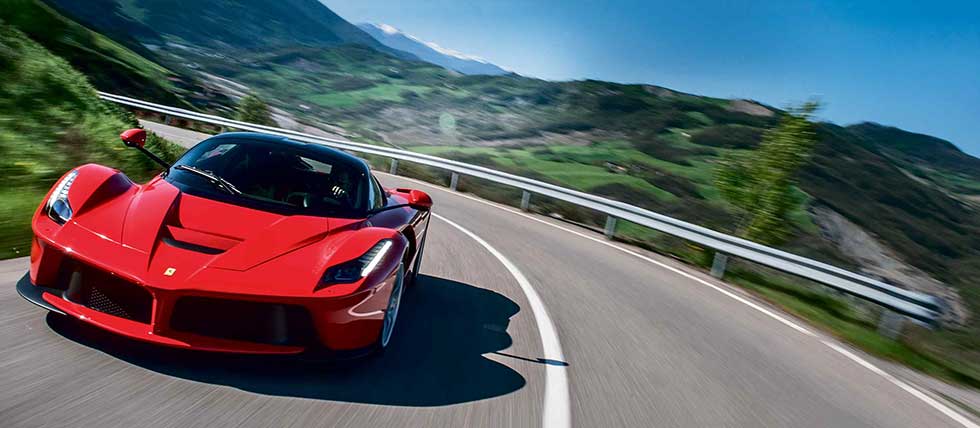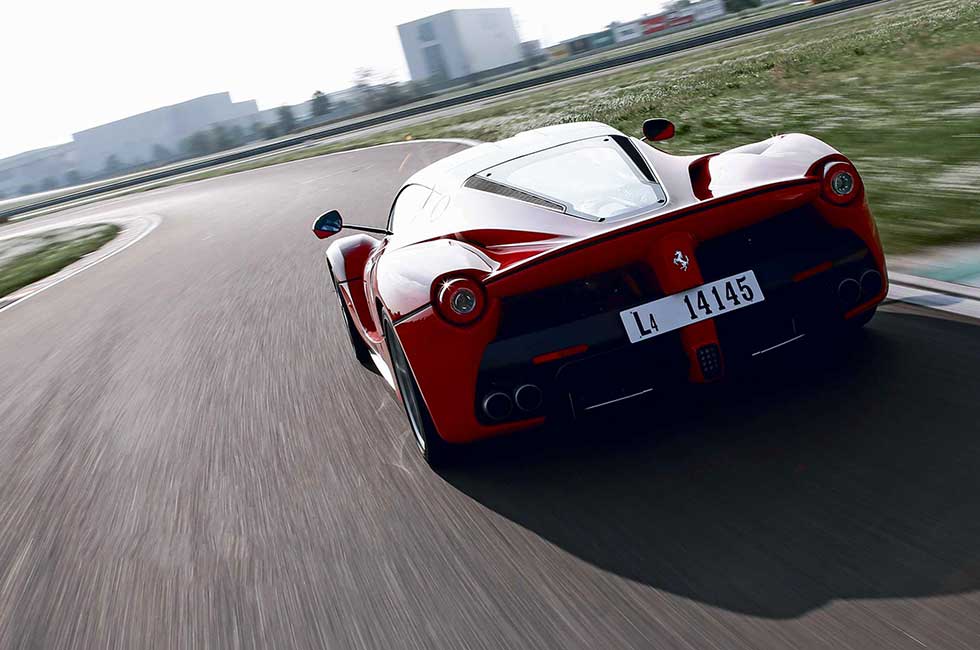
Legend! Laferrari The 950bhp hybrid hypercar. With the 986bhp SF90 Stradale on the horizon, we revisit Ferrari’s original hybrid hypercar, the 950bhp LaFerrari. Words Andrew Frankel. Photography Dean Smith.
FEATURE CAR LAFERRARI
HYPER HYBRID
Original hybrid hypercar – Coronavirus scuppered the press launch of the new, hybrid-powered SF90 Stradale, but here’s one they made earlier
On another day, or in another world, these words would have described what it was like to drive another near-1000bhp hybrid Ferrari hypercar. But then Covid-19 reared its corona-crowned head and the already-once-postponed launch of the SF90 Stradale was kicked into the run-off area once more.

Even so, it is hard to imagine how that hybrid could even have come into existence had it not been for this one. Without wishing to sound like a Blue Peter presenter hastily whipping out some pre-prepared pie from the oven and announcing ‘here’s one we made earlier’, the legacy of the LaFerrari in the SF90 is clear to see. In the seven years that now separate Ferrari’s first two hybrids, the lessons learned from the first project have turned a £1.2 million, 950bhp hypercar of which just 499 were built (plus 210 Apertas), into an approximately £450,000,986bhp supercar that’s part of the mainstream Ferrari line-up. And the SF90 has four-wheel drive, can be plugged in, and will drive itself on electricity alone (in which mode it is also Ferrari’s first front-wheel-drive car).
‘WILL SF90’S TURBO V8 MATCH A NATURALLY ASPIRATED V12?’
But I wonder which will prove to be more fun: will the SF90’s 4-litre turbo V8 prove more than a match both objectively and subjectively for the LaFerrari’s 6.3-litre naturally aspirated V12? Will the additional traction of four-wheel drive and the startling acceleration times it brings (try 0-62mph in 2.5sec) more than offset the weight gain that comes with it, too: an additional 150kg over the LaFerrari despite having only two thirds the cylinder-count and engine capacity.
All that, however, is for another time. For now, join me as I goggle in disbelief at the fact that it is already seven years since Ferrari’s hitherto most powerful road car was launched into our world.
Of course it was not born in a vacuum. On the contrary, its arrival coincided with two others at almost exactly the same time. Indeed, in the case of the LaFerrari and McLaren P1, at precisely the same 2013 motor show in Geneva, back in the days when there was one. Of course, both companies had known for a while about the Porsche 918 Spyder, which had been unveiled to stunned crowds in concept form three years earlier, but all three projects would have been greenlit without knowledge of the others. Extraordinary really.
‘THE LA FERRARI DOESN’T BLIND YOU WITH SCIENCE’
Together they were known as the hybrid hypercars, recognising and popularising a term for ultra-fast, super-expensive machinery only intermittently used up until then. But over time they became known somewhat sacrilegiously as The Holy Trinity, and it became the goal of every car journo to have driven all three. It took me years to join the club (because The Sunday Times replaced me on the Porsche launch with an inexperienced driver who crashed it) but, once I had, it was to me easy to understand their different approaches, their intended roles and how well they had achieved their aims.
The Porsche was a Porsche: a machine engineered, designed and executed so well you could quite easily forget you were in one of the world’s most potent automotive devices. You really could use it every day. And the McLaren was a McLaren, fast on paper but relatively faster still on a circuit. Full of dazzling driver aids such as DRS (Drag Reduction System) and IPAS (Instant Power Assist System) activated by buttons on the steering wheel, it wore its technology on its sleeve, promised an on-track experience unlike that of any road car built until that point, and then delivered on that promise in full.

The Ferrari? It wasn’t like those cars at all. On paper it was the fastest, insofar as it had the most power and best power-to-weight ratio, though I’ve seen so many different claims for the LaFerrari’s actual weight that I still don’t quite know which to believe. But if you’d heard nothing about it until the first moment you approached its scissored-up door, its secrets would remain just that. You could climb aboard, drive away, do a dozen laps of your favourite racetrack and still be unaware of exactly what trickery lay beneath. There are no magic buttons to press, you can’t plug it in or drive it on electricity alone. You could be forgiven for thinking it wasn’t a hybrid at all, but a car powered by nothing more than a naturally aspirated engine, albeit about ten litres in capacity.
‘I HAD NOT EXPECTED TO FEEL SO AT HOME IN THE LAFERRARI’
It was one of the things I found so enticing about the car.
For all its insane power, it didn’t seek to blind you with science, or intimidate you by making you activate different systems at different times to get the most from it. Its aero was indeed active, both front and rear, but like its hybrid drive, it was all entirely integrated and automated. All you had to do was choose which manettino setting you wanted and then drive, just as you would any other Ferrari.
Except what happened next was not like any Ferrari, or indeed any car there had been, Porsche and McLaren included. Enzo Ferrari loved V12s so much his company existed for nearly 30 years before he deigned to let his name be attached to a car powered by anything else. A V12 is the ultimate, surely? Well, no, as it happens, because not even Enzo would ever have imagined a hybrid-assisted V12.
Some will tell you that a naturally aspirated engine is less suited to hybridisation than a turbo motor, because in the latter you can use battery power to eliminate turbo lag. But Ferrari recognised from the start that its hybrid could be used in another way entirely, even more beneficial to an engine breathing air at atmospheric pressure. Because the limiting factor had always been torque, particularly in a Ferrari where the top-end bite you really wanted could only be achieved by sacrificing the mid-range shove you actually needed. The hybrid made that problem go away: Ferrari could tune its 6.3-litre V12 from the 730bhp at 8250rpm offered in the F12 to 789bhp at 9000rpm in the LaFerrari and simply fill in the resulting trough in the torque curve with electrons.
It worked perfectly, but then so does the whole car. I love the way the seat is fixed and you sit in a little recess in a tub made up from four different kinds of carbonfibre. The controls – wheel and pedals – come to you, which is not just convenient, it makes the car lighter because it doesn’t need seat motors, and lower for the same reason. Most of all, it stabilises and immobilises a potential 200kg mass (if there are two big blokes on board) in one fixed, central position.
The screens are clear and, at least by Ferrari standards, so is the switchgear. Unlike McLaren, Ferrari appears to have decided to make life as simple as possible for the driver, presumably on the assumption that he or she will have their hands more than full trying to tame this beast. It is, at least for anyone used to modern Ferraris, all very normal in here. At least until you point its prow out of the factory gates, hang a left and ease out onto Via Abetone.
It’s then that even the good folk of Maranello, who have absolutely seen it all before, start to point and stare. I hope no-one is going to argue that the LaFerrari is not also the best looking of ‘the trinity’, a fact seemingly confirmed by the shouts and gasps of the locals.
But it’s not much fun. At least not here and not yet: it’s too wide, over-the-shoulder visibility too restricted. You feel self-conscious too, or at least I do. So you head for the hills you know so well, onto roads used by Ferraris stradale and corsa for over 70 years, and discover that it doesn’t work brilliantly there either. In both its physical size and enormous potential, it has simply outgrown its environment.
It feels like a circus lion, claws clipped, padding impatiently around its too-small cage, hungry, frustrated and dangerous. You’re reduced to little, impotent jabs at the throttle, thrusting you forward as the powertrain strains against risk-averse electronics holding it back to spare the rear Pirellis. And even then it’s so fast that you’re already at the next corner before you’ve gone anywhere near that fabulous 9250rpm redline. On quicker, broader roads, you’re always in traffic, because the faster and wider the road, the more popular it will be, and in the LaFerrari if you leave one clump of cars and give it a squirt, you’ve already arrived at the next.
Which is why I’ve never been more pleased to see the gates of Fiorano and the chance, finally, to give the LaFerrari its freedom.
You’ll know from having attended trackdays that road cars on race racks never look fast. Except this one does. The sound, the energy, the majesty of it simply passing by on the main straight is awe-inspiring in the most literal, least cliched of senses. My turn comes and I start with a lap or two at a gentle pace (say a Porsche 911 being driven flat-out), just to bed myself in and because, if you know what to look for, a decent car will always reveal its true character long before you reach the limit.
And to my very considerable relief, amid the howling and shrieking of an uncorked V12 flinging itself past 9000rpm again and again, it is trying to reassure me. The steering is a little lighter than I’d like, and a touch too aggressive off-centre in that Ferrari way, but all the messages coming through the chassis tell me this car has my back.
‘THE SEAT IS FIXED. THE CONTROLS COME TO YOU’
Yet still there are difficulties: for instance the car has effectively remapped Fiorano for me. You no longer have time to think on the straight, and the left kink in its middle, which was always just part of the acceleration zone, is now a very definite corner, taken at well over 150mph and requiring a proper line. A line, mind, that brings you back to the left of the road because the braking points are also completely different, and you need to be mashing those massive carbon- ceramics even before you’re done exiting the kink.
And yet the only time it scared me was over a bump I’d scarcely noticed before. It’s a distinct kerthunk in an F12 and 458 as their suspension systems soak it up, but the LaFerrari near enough takes off. Which with a tight right shortly thereafter is not helpful. But with that duly noted, I flick the manettino through its race setting to turn off its stability systems, take a deep breath and go.
Only then am I sure what I feel about this car. Suddenly I realise how far Ferrari’s efforts to make a car that’s so intimidating on paper feel so unreasonably friendly to use have extended beyond the bounds of its ergonomics and systems integration. Whisper it, because there are those who’d like you to believe only a true track warrior can tame it, but up to, on and over the limit, the LaFerrari is an easy car to drive. Really. So long as you have the simple sense to recalibrate your brain to just how bloody fast it is going, the actual business of getting around a track, even with safety nets furled, is very straightforward.
It’s stable under brakes, understeers a little on entry, and then awaits your command. With 950bhp you can, of course, go as sideways as you like and for as long as you like, but so too does it let you decide. If deliciously neutral is the way you like it – and it is – that is the way you can have it.
I hoped I would be able to handle the LaFerrari and I could, but in it, certainly not in the single day we were together. But I did and now I know where it sits in the Holy Trinity. If the 918 Spyder is the one you’d use every day and the PI the one in which to wring out a lap time, the LaFerrari is the one you’d take for the simple and pure pleasure of driving. With a Ferrari, it should always be that way.
From the top: LaFerrari feels rather like a caged lion pacing the hill-routes around Maranello; driving environment will feel familiar if you’ve driven any modern Ferrari; no turbos to muffle the V12. From the top: Scissor doors add another layer of visual drama; author Frankel settles into his work; finally unleashed at Fiorano, the LaFerrari proves more pussycat than untameable beast Above: Far from being as intimidating as the specification suggests, Ferrari’s original hybrid hypercar is an easy car to bond with, though it needs big roads (or preferably a track) to show its true colours.
Ferrari’s hybrid hypercars: how they compare
LAFerrari
ENGINE V12. 6262cc. plus electric motor
MAX POWER 950bhp @ 9000rpm
MAX TORQUE 664lb ft+ @ 6750rpm
TRANSMISSION Seven-speed DCT, rear-wheel drive. ESC. E-Diff3, EF1-Trac
SUSPENSION Front: double wishbones, coil springs, adaptive dampers, anti-roll bar. Rear multi-link, coil springs, adaptive dampers, anti-roll bar
WEIGHT c1420kg (dry)
POWER TO WEIGHT 680bhp/ton
0-62MPH sub-3.0sec (claimed)
TOP SPEED 217mph+ (claimed)
PRICE c£1.2m
SF90 Stradale
ENGINE V8, 3990cc, twin-turbo, plus 3 electric motors
MAX POWER 986bhp @ 7500rpm
MAX TORQUE 590lb ft @ 6000rpm
TRANSMISSION Eight-speed DCT, four-wheel drive, eTC, E-Diff3, SSC
SUSPENSION Front: double wishbones, coil springs, adaptive dampers, anti-roll bar. Rear: multi-link, coil springs, adaptive dampers, anti-roll bar
WEIGHT 1570kg (dry)
POWER TO WEIGHT 637bhp/ton
0-62mph 2.5sec (claimed)
TOP SPEED 211mph (claimed)
PRICE c£450,000






